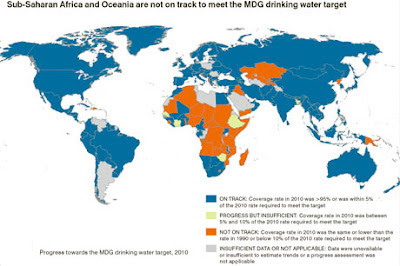The GOOD news
"Drinking Water Access" MDG
The Millennium Development Goal: Halve, by 2015, the proportion of people without sustainable access to safe drinking-water
Goal has been met ahead of schedule
By this measure:
(a) 89% of the global population (6.1 billion people) had access to clean drinking water by 2010,
(b) 92% of the global population will have access to safe drinking water by 2015, and
(c) Between 1990 and 2010, more than 2 billion people gained access to clean drinking water
The NOT-so-Good facts
1. An estimated 1.1 billion people still lack access to clean drinking water
2. 2.6 billion people don't have adequate sanitation
3. 1.8 billion people die every year from diseases associated with dirty water
A Global Crisis Looms
1. The MDG goal assessment (above) becomes clearer when the details are closely reviewed.
- Sub-Saharan Africa and Oceania (the orange colored areas) are NOT on track to meet Global drinking water access goals.
- Data at the country level also hides many extended periods of drought in many countries including those in the developed world (e.g. in Southwest USA and in Eastern Australia)
2. More than 40% of the world's population will live in areas experiencing high stress by 2050 (Source: Organization for Economic Cooperation and Development)
3. An additional US$30 billion is needed to provide access to everyone
4. Considering only population growth, rainfall amounts per person have dropped precipitously e.g. rainfall in Pakistan provided 5,000 cubic meters of freshwater for each person in 1947. Rainfall provides less than 1,000 cubic meters for each person today.
A few other facts
1. Food production is the single consumer of freshwater supplies today - over 80% of available freshwater supplies in Asia are used for growing food.
2. China, India and the US use roughly one-third of the roughly 4,000 cubic kilometers of freshwater extracted globally each year - India uses approx 13%, China uses approx 12% while the US uses approx 9%. (source: Fourth World Water Development Report by UNESCO)
3. Food demand is expected to rise by 70% by 2050
The way forward
 |
| Source - guardian.co.uk |
The Millennium Development Goal: Halve, by 2015, the proportion of people without sustainable access to safe drinking-water
Goal has been met ahead of schedule
By this measure:
(a) 89% of the global population (6.1 billion people) had access to clean drinking water by 2010,
(b) 92% of the global population will have access to safe drinking water by 2015, and
(c) Between 1990 and 2010, more than 2 billion people gained access to clean drinking water
The NOT-so-Good facts
1. An estimated 1.1 billion people still lack access to clean drinking water
2. 2.6 billion people don't have adequate sanitation
3. 1.8 billion people die every year from diseases associated with dirty water
A Global Crisis Looms
 |
| Source - |
- Sub-Saharan Africa and Oceania (the orange colored areas) are NOT on track to meet Global drinking water access goals.
- Data at the country level also hides many extended periods of drought in many countries including those in the developed world (e.g. in Southwest USA and in Eastern Australia)
2. More than 40% of the world's population will live in areas experiencing high stress by 2050 (Source: Organization for Economic Cooperation and Development)
3. An additional US$30 billion is needed to provide access to everyone
4. Considering only population growth, rainfall amounts per person have dropped precipitously e.g. rainfall in Pakistan provided 5,000 cubic meters of freshwater for each person in 1947. Rainfall provides less than 1,000 cubic meters for each person today.
A few other facts
1. Food production is the single consumer of freshwater supplies today - over 80% of available freshwater supplies in Asia are used for growing food.
2. China, India and the US use roughly one-third of the roughly 4,000 cubic kilometers of freshwater extracted globally each year - India uses approx 13%, China uses approx 12% while the US uses approx 9%. (source: Fourth World Water Development Report by UNESCO)
3. Food demand is expected to rise by 70% by 2050
The way forward
Technological Innovation or .....?
No comments:
Post a Comment